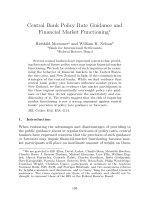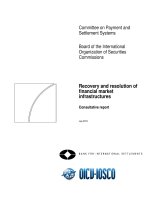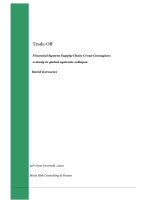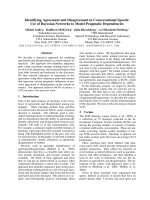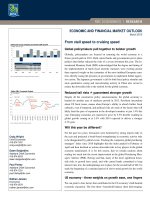ECONOMIC AND FINANCIAL MARKET OUTLOOK : Marking time until downside risks to global outlook fade doc
Bạn đang xem bản rút gọn của tài liệu. Xem và tải ngay bản đầy đủ của tài liệu tại đây (143.94 KB, 10 trang )
Craig Wright
Chief Economist
416-974-7457
Dawn Desjardins
Assistant Chief Economist
416-974-6919
Paul Ferley
Assistant Chief Economist
416-974-7231
Nathan Janzen
Economist
416-974-0579
ECONOMIC AND FINANCIAL MARKET OUTLOOK
December 2012
Marking time until downside risks
to global outlook fade
The latest International Monetary Fund (IMF) global growth outlook showed
another cut to the advanced and emerging economies’ forecasts. In 2012,
world GDP is forecasted to increase by 3.3% or 0.2 percentage points less than
what was expected in July. 2013’s growth forecast was trimmed by 0.3 per-
centage points to 3.6% to stand a full percentage point lower than the fore-
casted increase presented a year earlier. Notably, the trajectory for world
growth is upward even if the pace is expected to remain slower than its histori-
cal average. Weighing against a faster acceleration is the sharp reduction in
government spending and tax increases in many of the advanced countries.
The effect of this fiscal consolidation will in part be mitigated by central banks
maintaining very low policy rates. While in most jurisdictions this will be suf-
ficient to ensure that longer-term rates stay historically low, elevated financing
costs in some of the highly indebted European countries mean that the Euro-
pean Central Bank (ECB) will have to engage additional policies to align these
costs with the official policy rate.
In the immediate term, there remains a significant downside risk to the US
economy coming from the so called fiscal cliff. We see the probability that the
policies that are currently on the books will be enacted as being significantly
below 50%; instead, we expect a much smaller degree of fiscal restraint in
2013 than a full-blown fiscal cliff would entail. The risk of a deeper and
longer recession in Europe is also a key risk to the outlook. Recent data point
to the recession continuing in the final quarter of 2012 with negligible growth
forecasted at the start of 2013. The risk is that the structural and economic
reforms could prove too formidable and prevent Europe’s economy from ex-
panding. Policymakers to date have implemented several programs to ease
financial market concerns thereby resulting in a limited decline in financing
costs for the economies in the worst fiscal shape. Our view is that there are
enough irons in the fire to release the European economy from recession in
2013 with growth likely to accelerate in 2014.
Two steps forward; one step back
Even with these significant headwinds, the latest data were surprisingly upbeat
for China and the US although the same cannot be said for Europe. China’s
economy gradually picked up its pace in the course of 2012 and expanded at a
2.2% pace in the third quarter of the year. October reports suggest that this
momentum was, at least, maintained in the final quarter of 2012. Exports, in-
dustrial production, and retail trade posted solid gains in October, and the Pur-
chasing Managers’ Index rose above the key 50-mark in November for the
first time since October 2011. Policy actions by the government and the cen-
tral bank likely contributed to the stronger performance, and we expect the
-0.5
0.0
0.5
1.0
1.5
2.0
2.5
3.0
3.5
4.0
Canada U.S. UK Euro area
2011 2012 2013 2014
year-over-year, % change
Real GDP Growth
Source: International Monetary Fund, RBC Economics Research
2
economy will shift to a higher gear with real GDP growth increasing by 8.3%
on average in 2013 and 2014 from 7.8% in 2012
.
European data, however, showed a decidedly weaker tone early in the fourth
quarter of 2012. The Purchasing Managers’ Composite Index held stubbornly
below the 50-mark, which is consistent with a further contraction in economic
activity. The unemployment rate stood at an all-time high in the euro area as a
whole with outliers like Spain and Greece recording rates of 25%. Fiscal aus-
terity is biting and will keep some of the member countries in recession in
2013; however, with Germany, France, and Finland expected to post mild
growth, euro area GDP is likely to expand by a marginal 0.1% following
2012’s 0.4% decline. As the effect of the ‘shock and awe’ fiscal restraint di-
minishes, euro area growth is likely to accelerate with 2014 real GDP fore-
casted to rise by 1.0%.
US economy facing down fiscal cliff
The US economic data were surprisingly resilient this autumn with the hous-
ing market showing clear signs of a turnaround. Home sales, housing starts,
and selling prices all proved stronger than expected thereby setting up for real
residential investment to provide another quarterly boost to GDP in the final
quarter of 2012. US consumers also picked up their pace of spending on dura-
ble goods in the second half of 2012, and although Hurricane Sandy managed
to clip the pace of auto sales in late October, they roared back in November.
The Purchasing Managers’ Manufacturing Index failed to stay in expansionary
territory, which is consistent with a half-hearted rebound in fixed investment
in the final quarter of 2012 although the services-sector index moved higher.
Avoiding the fiscal cliff and clearing the air
As 2012 drew to a close, some businesses indicated that they were hesitant
about putting money to work given the uncertainties about how the govern-
ment will implement fiscal restraint. The range of estimates of the hit to the
economy in 2013 from the fiscal retracement is wide with some looking for a
cut of 4 to 5 percentage points. These estimates assume that legislation as cur-
rently written is enacted and that these effects are magnified by a drop in busi-
ness and consumer spending. Our assumptions remain that the government
will not implement spending sequestration and will maintain the middle-
income tax cut. If our assumptions are correct, this would significantly reduce
the size of the direct hit to the economy next year to about 1 percentage point.
While full implementation would likely result in the US economy falling back
into recession, our assumptions are consistent with the economy managing to
post moderate growth again in 2013. Furthermore, the less aggressive fiscal
medicine is likely to bolster confidence of households and businesses thereby
providing a lift to growth. The US economy is forecasted to grow by a modest
2.3% in 2013 with supportive monetary policy and a credible medium-term
plan to reduce the fiscal overruns likely to generate a stronger gain of 3.1% in
2014.
Housing recovery – it is for real
The persistent increases in housing sales and starts have been surprising. In
2012 to date, sales of new and existing single-family homes were 8.1% higher
than in 2011. Prices also recovered ground this year rising by about 10% from
the end of 2011. Housing starts increased by 28% from December 2011 al-
though are still running at just over half the 1.6 million unit pace demanded
due to demographic factors. Still, as recently as the summer of 2011, the pace
-3
-2
-1
0
1
2
2002 2003 2004 2005 2006 2007 2008 2009 2010 2011 2012 2013 2014
Source: Eurostat, RBC Economics Research
Forecasted values:
% change, quarter-over-quarter
Eurozone real GDP growth
Annual Growth Rates
Real GDP
2014f
1.0
2013f
0.1
2012f
-0.4
2011
1.5
-10
-8
-6
-4
-2
0
2
4
6
8
10
2000 2001 2002 2003 2004 2005 2006 2007 2008 2009 2010 2011 2012 2013 2014
Source: Bureau of Economic Anal
y
sis
,
RBC Economics Research
U.S. real GDP
Quarter-ov er-quarter annualized % change
Forecasted Values:
Annual Grow th Rates
2012f
2.2
2011
1.8
2010
2.4
2009
-3.1
Real GDP
2013f
2.3
2014f
3.1
0.3
0.3
0.3
-1.2
-1.0
-0.8
-0.6
-0.4
-0.2
0.0
0.2
0.4
0.6
2000 2001 2002 2003 2004 2005 2006 2007 2008 2009 2010 2011 2012 2013 2014
Contribution to Real GDP Change
Residential investments: U.S.
Source: Bureau of Economics Analysis, RBC Economics Research
Forecasted values:
3
of starts ran at 600,000 units at an annual rate, which was much lower than
October 2012’s 894,000 print. For 2012 as a whole, these gains set up for resi-
dential investment spending to add 0.3 percentage points to the economy’s
annual growth rate thereby marking the first contribution from this sector in
seven years. Looking to 2013, the Fed’s commitment to maintaining low inter-
est rates, via the fed funds target and ongoing purchases of mortgage-backed
securities, augurs well for the housing market to maintain its upward momen-
tum. We forecast that residential construction will again add 0.3 percentage
points to real GDP growth in both 2013 and 2014.
Job market primed to do better in 2013
Low interest rates are not the only support for housing as this is being aug-
mented by a firming in the labour market. In the course of 2012, the labour
market’s performance has been volatile. Having said that, in the 12 months
ended November 2012, there were 1.9 million jobs created, which was an ac-
celeration from the 1.7 million gain recorded in the same period last year. To
be sure, the improvement has been slow in coming. Job growth, according to
the household survey used to calculate the unemployment rate, accelerated
more sharply thereby resulting in the unemployment rate sliding below 8% in
September and staying there. The uncertainty about the fiscal cliff will likely
limit the labour market’s improvement in the near term; however, the effect
will fade in early 2013 thereby making it likely that job growth will accelerate
and further facilitate a strengthening in consumer spending and real estate ac-
tivity. Our forecast assumes that the pace of employment gains will accelerate
during 2013-2014 with the unemployment expected to end 2014 at 7.4%.
Balance sheet rebuild
The health of household balance sheets is improving with net worth recovering
84% of losses incurred during the recession. Liabilities were pared by almost
$1 trillion; however, the bigger force was the surge in financial asset values
augmented recently by increasing real estate values. Households saw their
equity in real estate assets rise to 44.8% as of the third quarter of 2012 from
37.2% in early 2009 and much closer to the average of the previous decade.
The rebuilding of net worth, low interest rates and gradually improving labour
market conditions are constructive for consumer spending. Additionally, sen-
ior loan officers indicated that standards for consumer loans have eased
thereby providing another support for household spending in 2013. One factor
that is likely to limit an acceleration in the near term is the expected reversal of
the payroll tax cut that will reduce disposable incomes as of January 1, 2013.
This is likely to limit spending growth in the first half of 2013; however, faster
hiring and wage gains will be sufficient to offset the drag from the payroll tax
increase, and we anticipate consumer spending will grow at a 2.8% pace in the
second half of 2013 and average 2.6% in 2014.
Business balance sheets have bench strength
US corporations remain cautious and reduced investment in capital goods and
non-residential real estate in the third quarter of 2012. This pullback likely was
a product of rising anxiety about the US election and the extent of fiscal re-
straint measures. Financial institutions indicated that lending standards remain
supportive, and with interest rates low, access to financing for most companies
was not an impediment. Profit growth slowed; although relative to the size of
the economy, pre-tax profits are near historic highs. Furthermore, companies
are holding a historically high amount of liquid assets relative to their liabili-
ties and the economy’s GDP. As long as the uncertainty about the implementa-
2
3
4
5
6
7
8
9
10
11
2000 2001 2002 2003 2004 2005 2006 2007 2008 2009 2010 2011 2012 2013 2014
Source: Bureau of Labor Statistics, RBC Economics Research
%
Unemployment rate: U.S.
Forecast
40
45
50
55
60
65
70
2005 2006 2007 2008 2009 2010 2011 2012
$ trillions
U.S. net wealth
Source: Federal Reserve
-30
-20
-10
10
20
2005 2006 2007 2008 2009 2010 2011 2012 2013 2014
quarter-over-quarter, % change
Real Business Fixed Investment
Source: Bureau of Economics Analysis, RBC Economics Research
Forecast
4
tion of fiscal restraint persists, business investment is likely to remain tepid;
however, once the issue is resolved, US business spending is forecasted to
accelerate in 2013 and 2014.
Inflation stays contained leaving Fed to focus on unem-
ployment
The US Federal Reserve’s dual mandate is to provide price stability and full
employment with the first criterion being met by both the headline and core
inflation rates at around 2% in October. In 2013, both of these inflation rates
are expected to fall below the 2% target as energy prices stabilize and food
prices move only marginally higher due to the drought of this past summer.
That leaves the Fed to focus on the labour market because the unemployment
rate at 7.7% remains well above the 5.2% to 6.0% full-employment range.
Policy remains geared to lowering the unemployment rate with the Fed ex-
pected to maintain a very low fed funds target until mid-2015. This stimulative
policy will work to mitigate some of fiscal policy restraint on the overall econ-
omy’s growth rate.
External risks keep the Bank of Canada on the sidelines
The myriad of external risks, slowing domestic investment, and a drop in ex-
ports that depressed growth in the third quarter of 2012 to a 0.6% annualized
rate in Canada saw the Bank of Canada maintain the policy rate at a very
stimulative 1.0%. To be sure, the economy is running with relatively limited
excess capacity, but the below-potential gain recorded in the third quarter
opened the output gap a little wider meaning, all else being equal, that it will
take longer to close the gap than previously estimated. Until the external risks
tone down, stimulative domestic monetary policy will serve to insulate the
economy from persistently weak export demand. The headline and core infla-
tion rates stand closer to the bottom end of the 1% to 3% target band than the
top, so there is no urgency for the Bank to Canada to reduce policy stimulus.
Our expectation is that the downside risks to the global economy from the US
and European economies will dissipate in early 2013 thereby providing a boost
to household and business confidence worldwide. Canada will be no exception
with the clearer outlook expected to support consumer and business spending
in 2013. Exports have lagged during recent years although firming demand in
the US and a gradual stabilization in Europe will turn the dial in terms of ex-
port growth in 2013 and 2014. At the same time, import demand will continue
to grow, albeit at a subdued pace. After a sustained period of net exports act-
ing as a drag on real GDP, the trade sector is forecasted to boost growth in
2013 and 2014. With the economy expanding at an above-potential growth
rate, the Bank of Canada will be in a position to start to reduce monetary pol-
icy stimulus with the policy rate forecasted to rise 50 basis points to 1.5% by
the end of 2013 and a further 50 basis points to 2.0% by the end of 2014.
Trade – the hope for 2013
Canadian exports have significantly trailed the recovery performance of both
the recession of the early 1980s and the early 1990s. In fact, to date, the level
of exports stands below its previous peak. This contrasts to the level of both
household spending and business investment, which eclipsed their previous
peaks. Export growth has been held back by weak demand for a number of
goods including motor vehicles and parts, industrial machinery, and aircraft.
Conversely, exports of energy products and metals stand at new all-time highs.
Looking ahead to 2013, as the fiscal cloud lifts, stronger US demand is ex-
0
1
2
3
4
5
6
7
2000 2001 2002 2003 2004 2005 2006 2007 2008 2009 2010 2011 2012 2013 2014
Source: Federal Reserve, RBC Economics Research
%
Forecast
Interest rates: U.S.
10 Year Bond Yield
Fed Funds Rate
0
1
2
3
4
5
6
7
2000 2001 2002 2003 2004 2005 2006 2007 2008 2009 2010 2011 2012 2013 2014
Source: Bank of Canada, RBC Economics Research
%
Forecast
Interest rates: Canada
10 Year Bond Yield
BoC Overnight Rate
80
90
100
110
120
130
140
150
160
170
t-8
t-6
t-4
t-2
peak
t+2
t+4
t+6
t+8
t+10
t+12
t+14
t+16
t+18
t+20
t+22
t+24
Q2-1981
Q1-1990
Q3-2008
Index = 100 at pre-recession GDP peaks
Canada Exports: Indexed to Pre-recession Peak
Forecast
Source: Statistics Canada, RBC Economics Res earch
5
pected to emerge with motor vehicle and parts exports likely to rise alongside
higher US auto sales. Elevated demand for commodities, especially as China
shifts into higher gear, augurs well for exports of energy and metals to con-
tinue to be firm. Import growth is also expected to accelerate although the
pace of increase is likely to be slower than exports given the very rapid in-
creases recorded in 2010-2011. From the recent low recorded in mid-2009,
Canadian purchases of imported machinery and equipment surged by 52%.
We expect the pace to slow in 2013 although still anticipate that overall import
growth will rise over the next two years. Net trade is forecast to make contri-
butions of 0.3 percentage points and 0.4 percentage points to real GDP growth
in 2013 and 2014 respectively. This represents the most significant support
since 2001 after most of the intervening years showed the sector acted as a
drag on growth.
Business balance sheet health paves way for investment
Canadian nonfinancial corporations saw profits recover from the 60% drop
recorded during the Great Recession. As of the third quarter of 2012, profits as
a percent of GDP stood at 9.5%, in line with historical averages. Corporations
have also been building up the amount of cash and deposits on their balance
sheets. In part, this likely is a reflection of businesses shying away from put-
ting money to work given the uncertain global economic outlook. It may also
reflect a build up of cash reserves to meet an anticipated increase in expenses
such as unfunded pension liabilities. The Bank of Canada’s quarterly Business
Outlook survey showed that the majority of companies intend to increase in-
vestment in machinery and equipment over the next 12 months and to boost
head count. That said the margin of companies expecting to increase spending
and hiring shrunk. The survey also indicated that lending standards, from both
the lender and borrower perspective, remain accommodative providing compa-
nies with the capital needed to fund investment at current low interest rates.
While businesses are facing supportive conditions, the uncertain global envi-
ronment restrained spending on capital goods in the first three quarters of
2012. Spending on structures continued at a brisk clip which we expect to con-
tinue given the declines in the vacancy rates in recent quarters. We further
expect that as the uncertainty gripping the world economy ebbs, corporations
will take advantage of their enviable balance sheet positions and resume
spending on machinery and equipment at a faster rate.
Household balances – that is another story
Canadian households drove up the debt-to-personal income ratio to an all-time
high of 163% in the second quarter. The debt drive was facilitated by a conflu-
ence of factors – solid labour market conditions; low interest rates, access to
loans and a robust housing market. While some of the factors that led consum-
ers to push up their debt levels are still present today, the government’s tight-
ening of the mortgage rules plus a cooling in the housing market activity are
likely to contribute to a steady moderation in debt accumulation going for-
ward. In fact, this trend is already underway with household credit growth in
September and October running at the slowest rate since 2002. The easing is a
reflection of a sharp slowing in consumer credit combined with mortgage debt
growing at a 6.6% pace compared to a year ago. This followed two years of
mortgage growth running between 7% and 8%. This easing in the pace of debt
accumulation is a step in the right direction although it has been tempered by
the fact that the pace of personal income growth has been lacklustre to-date.
The tightening in labour market conditions and acceleration in the pace of
wage increases may act to remedy this situation soon.
-40
-30
-20
-10
10
20
30
40
50
60
2002 2002 2003 2004 2005 2005 2006 2007 2008 2008 2009 2010 2011 2011 2012
Future Employment Level
Investment in Machinery & Equipment
Quarter-over-quarter, % change
Business Intentions Survey
Source: Bank of Canada
2
4
6
8
10
12
14
16
2000 2002 2004 2006 2008 2010 2012
Consumer credit Residential mortgage credit
Source: Bank of Canada, RBC Economics Research
% change, year-over-year
Household credit growth: Canada
432
444
456
410
420
430
440
450
460
470
2010 2011 2012 2013 2014
Source: Canadian Real Estate Association, RBC Economics Research
Thousands of units
Home resales: Canada
Forecasted values:
6
Cooling in housing market
Activity in the housing market cooled over the spring and summer although
the slide subsided with sales rising in September and maintaining the gain in
October. The weaker sales followed an unexpectedly robust first quarter
spurred by unseasonably warm weather and a round of mortgage rate promo-
tions. The tightening in mortgage rules that took effect in July amplified the
pullback already underway at the time. The near-term outlook for housing is
for a sustained weakening in activity albeit at a modest pace. This reflects
stretched affordability relative to historical averages, high levels of household
indebtedness relative to incomes, and global uncertainty. Some offset will be
provided by interest rates remaining historically low. We look for lower resale
activity and home prices in Canada in 2013 and 2014.
Canadian dollar rally is not done yet
The Canadian dollar traded in a well worn range around parity against the US
dollar in 2012. We remain bullish on the Canadian dollar based on our view
that commodity prices will remain historically high, interest rates in Canada
will rise quicker than in the US, and foreign investors will continue to put their
money into Canadian assets, which have a higher rating than many others. Our
spot forecast is for the Canadian dollar to gain another 5% against the US in
2013.
The currency’s strengthening has reduced the cost of imported goods and ser-
vices and in turn filtered into some components of the consumer price index
(CPI). This is most evident in the clothing and footwear category where prices
are 9% lower than in 2002 when the Canadian dollar hit the bottom against the
US dollar. Even outside this structural decline in clothing prices, inflation
pressures in Canada are well contained with the headline rate at 1.2% in Octo-
ber and the core measure at 1.3%. In 2013, a gradual elimination of excess
capacity will likely result in upward pressure being exerted on prices; although
given the low starting point, the rates are only likely to approach the 2% target
by the end of 2013. Inflation pressures may become more of an issue in 2014
as the economy starts the year expanding at an above-potential pace; however,
we expect that the Bank of Canada will be in the process of reducing policy
stimulus and that will cap the upside for prices.
Canada – the little economy that could
The recent respite in growth raised concerns that Canada’s economic outper-
formance had run its course. A scan of the data shows that there were a variety
of one-off factors that limited the expansion in the third quarter of 2012. In
late 2012 and early 2013, these factors that served to weigh on growth will
reverse course thereby arguing for a recovery also supported by easy financial
conditions and very low household borrowing rates. As the cloak of uncer-
tainty is removed from the global economy, demand for Canadian exports will
rise as will investment and hiring. The overall economy is headed for a period
of gradual improvement and the gradual elimination of excess capacity. As the
economy edge ever nearer to full employment, the case for interest rates to
stay as low as they are will dwindle. We expect the Bank to implement a plan
of gradual and persistent rate increases starting in the second half of 2013 and
continuing in 2014.
20
40
60
80
100
120
140
160
180
200
1990 1992 1994 1996 1998 2000 2002 2004 2006 2008 2010 2012
Source: Bank of Canada, RBC Economics Research
Indexed to 2007-01 = 100
BoC Commodity Price Index
-10
-8
-6
-4
-2
0
2
4
6
8
2000 2001 2002 2003 2004 2005 2006 2007 2008 2009 2010 2011 2012 2013 2014
Source: Statistics Canada, RBC Economics Research
Canada's real GDP
quarter-over-quarter % change, annualized rate
Forecasted values:
Annual Growth Rates
2012f
2.0
2011
2.6
2010
3.2
Real GDP
2013f
2.4
2014f
2.8
0.60
0.70
0.80
0.90
1.00
1.10
95 96 97 98 99 00 01 02 03 04 05 06 07 08 09 10 11 12 13 14
Forecast
Source: Bank of Canada, RBC Economics Research
Parity
Canadian dollar forecast
US$/C$
End of period rates
2013f
1.05
2012f
1.01
2011
0.98
2010
1.00US$/C$
2014f
1.04
7
Economic forecast detail — Canada
Real growth in the economy
Quarter-over-quarter annualized % change unless otherwise indicated
Other indicators
Year-over-year % change unless otherwise indicated
*Period average
Source: Statistics Canada, RBC Economics Research forecasts
Actual
Q1 Q2 Q3 Q4 Q1 Q2 Q3 Q4 Q1 Q2 Q3 Q4 2011 2012 2013 2014
Household Consumption
2.2 0.6 3.8 2.2 2.3 2.4 2.7 2.6 2.3 2.2 2.2 2.2 2.4 2.0 2.5 2.4
Durables
3.6 -4.3 5.7 5.4 3.7 3.3 2.9 2.7 2.0 2.5 2.4 2.4 1.8 2.7 3.5 2.5
Semi-Durables
3.4 -3.5 3.1 2.0 3.0 2.3 3.3 2.9 2.5 2.5 2.5 2.5 2.8 2.1 2.3 2.7
Non-durables
-2.3 2.5 1.9 2.0 2.1 2.3 3.5 2.8 2.5 2.1 2.1 2.1 1.4 0.5 2.3 2.5
Services
3.9 1.3 4.3 1.7 2.0 2.3 2.3 2.4 2.3 2.1 2.1 2.1 2.9 2.5 2.3 2.2
NPISH consumption
3.5 -2.8 4.3 2.2 2.3 2.4 2.7 2.6 2.3 2.2 2.2 2.2 4.5 1.9 2.3 2.4
Government expenditures
-1.7 0.1 1.2 0.5 0.2 0.2 0.2 0.2 0.4 0.4 0.4 0.4 1.0 0.2 0.4 0.3
Government fixed investment
1.5 3.5 -6.0 1.0 0.5 0.5 0.5 0.5 0.6 0.6 0.6 0.6 -3.3 -6.2 -0.1 0.6
Residential investment
15.5 -0.2 -3.5 -1.8 -4.3 -3.7 -2.3 -1.1 -0.6 -1.3 -0.5 0.1 1.9 5.6 -2.9 -1.2
Non-residential investment
6.9 8.8 -2.5 0.9 6.5 7.9 9.0 8.2 7.1 6.3 6.5 5.8 10.4 5.5 5.1 7.3
Non-residential structures
9.0 14.2 -4.4 -0.5 6.9 7.8 8.9 8.0 7.6 6.5 6.9 6.0 10.2 7.1 4.9 7.4
Machinery & equipment
4.1 1.6 0.2 3.0 5.9 8.0 9.1 8.5 6.4 6.0 6.0 5.5 10.7 3.3 5.3 7.0
Intellectual property
-11.4 4.8 3.9 7.1 8.3 8.1 7.7 8.1 8.9 8.0 8.2 8.1 9.0 1.0 7.2 8.2
Final domestic demand
2.4 1.4 1.6 1.5 1.9 2.2 2.5 2.4 2.3 2.1 2.1 2.1 2.7 1.8 1.9 2.3
Exports
-3.1 0.1 -7.8 8.9 6.8 7.2 7.8 7.8 7.5 6.8 7.0 7.0 4.6 1.9 5.1 7.4
Imports
3.8 1.9 1.7 3.5 3.1 5.5 5.1 5.8 5.5 5.0 6.1 6.1 5.8 2.8 3.8 5.5
Inventories (change in $b)
4.0 5.9 12.2 8.8 6.5 7.1 7.8 8.8 9.4 8.0 7.3 6.8 1.6 7.7 7.5 7.9
Real gross domestic product 1.7 1.7 0.6 2.2 2.4 2.7 3.4 3.2 2.9 2.2 2.2 2.2 2.6 2.0 2.4 2.8
2014
Forecast
2013 year-over-year % change2012
Forecast
Actual
Business and labour
Productivity
1.1 1.3 0.4 -0.4 -0.4 0.4 1.2 1.6 1.7 1.6 1.3 1.1 1.1 0.6 0.7 1.5
Pre-tax corporate profits
3.3 0.9 -2.3 -6.6 -0.8 5.6 6.1 8.6 8.5 8.2 7.3 5.5 15.2 -1.3 4.8 7.3
Unemployment rate (%)*
7.4 7.3 7.3 7.3 7.3 7.2 7.0 7.0 7.0 6.9 6.9 6.8 7.5 7.3 7.1 6.9
Inflation
Headline CPI
2.3 1.6 1.2 1.2 1.2 1.5 1.9 1.9 1.9 1.9 2.0 2.0 2.9 1.6 1.7 2.0
Core CPI
2.1 2.0 1.5 1.5 1.8 1.8 2.0 1.9 1.9 1.9 2.0 2.0 1.7 1.8 1.9 2.0
External trade
Current account balance ($b)
-64.4 -73.5 -75.6 -45.9 -43.5 -42.4 -41.7 -40.5 -39.1 -37.6 -36.9 -36.5 -52.3 -64.9 -42.0 -37.5
% of GDP
-3.6 -4.1 -4.1 -2.5 -2.3 -2.2 -2.2 -2.1 -2.0 -1.9 -1.8 -1.8 -3.0 -3.6 -2.2 -1.9
Housing starts (000s)*
206 231 222 202 193 185 184 181 179 175 174 173 194 215 185 175
Motor vehicle sales (mill., saar)*
1.75 1.72 1.69 1.72 1.74 1.76 1.77 1.77 1.77 1.78 1.78 1.79 1.62 1.72 1.76 1.78
8
Economic forecast detail — United States
Real growth in the economy
Quarter-over-quarter annualized % change unless otherwise indicated
Other indicators
Year-over-year % change unless otherwise indicated
*Period average
Source: Bureau of Economic Analysis, RBC Economics Research forecasts
Actual
Q1
Q2 Q3 Q4 Q1 Q2 Q3 Q4 Q1 Q2 Q3 Q4 2011 2012 2013 2014
Consumer spending 2.4 1.5 1.4 1.9 1.7 2.2 2.8 2.9 2.5 2.5 2.6 2.7 2.5 1.8 2.0 2.6
Durables 11.5 -0.2 8.7 7.7 4.2 5.7 7.0 7.1 5.9 5.9 6.0 6.1 7.2 7.4 5.9 6.3
Non-durables 1.6 0.6 1.1 1.4 0.8 1.6 2.6 3.0 2.3 2.3 2.5 2.5 2.3 1.0 1.5 2.5
Services 1.3 2.1 0.3 1.1 1.5 1.8 2.1 2.2 2.0 2.0 2.1 2.2 1.9 1.2 1.5 2.1
Government spending -3.0 -0.7 3.5 -1.0 -1.0 -1.0 -0.9 -0.9 0.1 0.1 0.4 0.4 -3.1 -1.4 -0.4 -0.2
Residential investment 20.6 8.4 14.3 15.2 12.7 9.7 10.5 11.2 12.7 14.2 14.6 14.9 -1.4 12.0 12.1 12.6
Non-residential investment 7.5 3.6 -2.2 2.6 4.0 9.6 9.4 8.4 8.1 8.6 8.4 8.0 8.6 7.3 4.9 8.5
Non-residential structures 12.8 0.6 -1.0 2.6 2.6 9.5 8.9 7.8 7.8 7.8 8.0 8.0 2.8 9.7 4.4 8.1
Equipment & software 5.4 4.8 -2.7 2.6 4.5 9.7 9.6 8.6 8.2 8.9 8.5 8.0 11.0 6.3 5.1 8.7
Final domestic demand 2.2 1.4 1.7 1.7 1.6 2.5 2.9 2.9 2.8 2.9 3.0 3.1 1.8 1.9 2.1 2.9
Exports 4.4 5.2 1.1 -0.5 7.0 9.3 8.1 7.8 8.3 8.4 8.4 8.4 6.7 3.5 5.3 8.3
Imports 3.1 2.8 0.1 -1.0 6.0 7.5 6.3 5.3 6.9 7.5 7.5 7.5 4.8 2.7 4.0 6.8
Inventories (change in $b) 56.9 41.4 61.3 45.3 58.1 61.8 58.5 63.2 65.2 68.2 69.2 76.2 47.2 64.6 52.4 57.5
Real gross domestic product 2.0 1.3 2.7 1.4 2.0 2.7 3.0 3.3 3.0 3.0 3.1 3.3 1.8 2.2 2.3 3.1
year-over-year % change
Forecast
2012
2013
Forecast
Actual
2014
Business and labour
Productivity
0.9 1.1 1.4 0.7 1.0 0.9 0.9 1.3 1.5 1.5 1.4 1.4 0.4 1.0 1.0 1.4
Pre-tax corporate profits
10.3 6.7 8.7 1.9 6.8 6.3 3.8 5.1 4.1 4.5 4.5 4.7 7.3 6.7 5.5 4.4
Unemployment rate (%)*
8.3 8.2 8.1 7.8 7.9 8.0 7.9 7.8 7.7 7.6 7.5 7.4 9.0 8.1 7.9 7.6
Inflation
Headline CPI
2.8 1.9 1.7 1.9 1.4 1.7 1.7 1.8 1.9 1.9 1.8 1.9 3.2 2.1 1.7 1.9
Core CPI
2.2 2.3 2.0 2.0 1.9 1.8 1.7 1.7 1.8 1.8 1.8 1.9 1.7 2.1 1.8 1.8
External trade
Current account balance ($b)
-534 -470 -424 -422 -429 -430 -428 -424 -428 -434 -439 -442 -466 -463 -428 -436
% of GDP
-3.5 -3.0 -2.7 -2.6 -2.7 -2.6 -2.6 -2.6 -2.5 -2.6 -2.6 -2.5 -3.1 -2.9 -2.6 -2.5
Housing starts (000s)*
715 736 780 853 875 898 947 996 1063 1135 1212 1295 612 771 929 1176
Motor vehicle sales (millions, saar)*
14.1 14.1 14.5 14.8 14.5 14.6 14.8 15.0 15.1 15.2 15.3 15.4 12.7 14.4 14.7 15.2
9
Financial market forecast detail
Interest rates—North America
%, end of period
Interest rates—International
%, end of period
Actual
12Q1 12Q2 12Q3 12Q4 13Q1 13Q2 13Q3 13Q4 14Q1 14Q2 14Q3 14Q4 2011 2012 2013 2014
C
ana
d
a
Overnight 1.00 1.00 1.00 1.00 1.00 1.00 1.25 1.50 1.50 1.75 2.00 2.00 1.00 1.00 1.50 2.00
Three-month 0.92 0.88 0.90 1.05 1.05 1.10 1.25 1.50 1.55 1.80 2.05 2.10 1.10 1.05 1.50 2.10
Two-year 1.20 1.03 1.15 1.05 1.10 1.40 1.65 1.90 2.10 2.25 2.40 2.50 1.00 1.05 1.90 2.50
Five-year 1.56 1.25 1.35 1.30 1.45 1.75 1.95 2.15 2.40 2.55 2.70 2.80 1.50 1.30 2.15 2.80
10-year 2.11 1.74 1.75 1.75 1.85 2.15 2.35 2.45 2.60 2.75 3.00 3.40 2.30 1.75 2.45 3.40
30-year 2.64 2.33 2.40 2.40 2.45 2.60 2.75 2.95 3.05 3.20 3.40 3.60 3.10 2.40 2.95 3.60
Yield curve (10s-2s) 91 71 60 70 75 75 70 55 50 50 60 90 130 70 55 90
United States
Fed funds 0.13 0.13 0.13 0.13 0.13 0.13 0.13 0.13 0.13 0.13 0.13 0.13 0.13 0.13 0.13 0.13
Three-month 0.07 0.05 0.05 0.05 0.05 0.05 0.05 0.05 0.05 0.05 0.05 0.05 0.05 0.05 0.05 0.05
Two-year 0.34 0.25 0.25 0.25 0.25 0.25 0.35 0.45 0.65 0.85 1.00 1.25 0.30 0.25 0.45 1.25
Five-year 1.04 0.70 0.72 0.70 0.85 0.90 1.05 1.20 1.40 1.50 1.75 2.00 1.10 0.70 1.20 2.00
10-year 2.20 1.60 1.65 1.70 1.95 2.10 2.25 2.40 2.55 2.65 2.95 3.25 2.15 1.70 2.40 3.25
30-year 3.32 2.70 2.80 2.90 3.25 3.45 3.60 3.85 3.95 4.00 4.20 4.50 3.20 2.90 3.85 4.50
Yield curve (10s-2s) 186 135 140 145 170 185 190 195 190 180 195 200 185 145 195 200
Yield spreads
Three-month T-bills 0.85 0.83 0.85 1.00 1.00 1.05 1.20 1.45 1.50 1.75 2.00 2.05 1.05 1.00 1.45 2.05
Two-year 0.86 0.78 0.90 0.80 0.85 1.15 1.30 1.45 1.45 1.40 1.40 1.25 0.70 0.80 1.45 1.25
Five-year 0.52 0.55 0.63 0.60 0.60 0.85 0.90 0.95 1.00 1.05 0.95 0.80 0.40 0.60 0.95 0.80
10-year -0.09 0.14 0.10 0.05 -0.10 0.05 0.10 0.05 0.05 0.10 0.05 0.15 0.15 0.05 0.05 0.15
30-year -0.68 -0.37 -0.40 -0.50 -0.80 -0.85 -0.85 -0.90 -0.90 -0.80 -0.80 -0.90 -0.10 -0.50 -0.90 -0.90
Actual Forecast Forecast
Actual
12Q1 12Q2 12Q3 12Q4 13Q1 13Q2 13Q3 13Q4 14Q1 14Q2 14Q3 14Q4 2011 2012 2013 2014
United Kingdom
Repo 0.50 0.50 0.50 0.50 0.50 0.50 0.50 0.50 0.50 0.50 0.50 0.50 0.50 0.50 0.50 0.50
Two-year 0.43 0.40 0.20 0.20 0.20 0.20 0.30 0.30 0.30 0.30 0.40 0.40 0.70 0.20 0.30 0.40
10-year 2.00 1.80 1.70 1.70 1.75 1.80 2.00 2.00 2.00 2.25 2.35 2.50 2.45 1.70 2.00 2.50
Euro Area
Refinancing rate 1.00 1.00 0.75 0.75 0.75 0.75 0.75 0.75 0.75 0.75 0.75 0.75 1.00 0.75 0.75 0.75
Two-year 0.09 0.10 0.00 0.00 0.10 0.15 0.20 0.25 0.30 0.30 0.40 0.40 0.65 0.00 0.25 0.40
10-year 1.61 1.50 1.50 1.50 1.60 1.70 1.85 2.00 2.00 2.10 2.20 2.25 2.20 1.50 2.00 2.25
Australia
Cash target rate 4.25 3.50 3.50 3.00 3.00 2.75 2.75 2.75 2.75 2.75 2.75 3.00 4.25 3.00 2.75 3.00
Two-year 3.49 2.46 2.49 2.75 2.60 2.60 2.70 2.80 2.90 3.00 3.10 3.20 3.15 2.75 2.80 3.20
10-year 4.10 3.04 2.94 3.00 3.25 3.30 3.45 3.60 3.75 3.90 4.25 4.75 4.05 3.00 3.60 4.75
New Zealand
Cash target rate 2.50 2.50 2.50 2.50 2.50 2.50 2.50 2.50 2.75 3.00 3.00 3.25 2.50 2.50 2.50 3.25
Two-year 3.11 2.37 2.55 2.60 2.70 2.70 2.80 2.90 3.00 3.20 3.40 3.50 2.85 2.60 2.90 3.50
10-year 4.17 3.40 3.57 3.80 4.00 4.10 4.25 4.50 4.70 4.80 5.10 5.50 4.25 3.80 4.50 5.50
Forecast ForecastActual
10
Exchange rates
%, end of period
Note: Exchange rates are expressed in units per USD, with the exception of the Euro, GBP, AUD, and NZD, which are expressed in USD per local cur-
rency unit.
Source: Reuters, RBC Economics Research forecasts
The material contained in this report is the property of Royal Bank of Canada and may not be reproduced in any way, in whole or in
part, without express authorization of the copyright holder in writing. The statements and statistics contained herein have been pre-
pared by RBC Economics Research based on information from sources considered to be reliable. We make no representation or war-
ranty, express or implied, as to its accuracy or completeness. This publication is for the information of investors and business persons
and does not constitute an offer to sell or a solicitation to buy securities.
Actual
12Q1 12Q2 12Q3 12Q4 13Q1 13Q2 13Q3 13Q4 14Q1 14Q2 14Q3 14Q4 2011 2012 2013 2014
Australian dollar 1.03 1.02 1.04 1.05 1.06 1.05 1.04 1.03 1.03 1.03 1.02 1.02 1.02 1.05 1.03 1.02
Brazilian real 1.83 2.01 2.03 2.00 1.98 1.96 1.94 1.93 N/A N/A N/A N/A 1.87 2.00 1.93 N/A
Canadian dollar 1.00 1.02 0.98 0.99 1.00 0.98 0.96 0.95 0.95 0.94 0.95 0.96 1.02 0.99 0.95 0.96
Renminbi 6.30 6.35 6.28 6.30 6.25 6.20 6.15 6.15 N/A N/A N/A N/A 6.30 6.30 6.15 N/A
Euro 1.33 1.27 1.29 1.30 1.32 1.29 1.27 1.24 1.24 1.24 1.23 1.23 1.30 1.30 1.24 1.23
Yen 838078817775737271717273 77 817273
Mexican peso 12.81 13.36 12.86 12.75 12.75 12.65 12.50 12.25 N/A N/A N/A N/A 13.94 12.75 12.25 N/A
New Zealand dollar 0.82 0.80 0.83 0.83 0.82 0.81 0.80 0.79 0.79 0.79 0.78 0.78 0.78 0.83 0.79 0.78
Swiss franc 0.90 0.95 0.94 0.92 0.91 0.93 0.95 0.98 0.99 0.99 1.01 1.01 0.94 0.92 0.98 1.01
U.K. pound sterling 1.60 1.57 1.62 1.63 1.67 1.65 1.65 1.65 1.65 1.65 1.62 1.62 1.55 1.63 1.65 1.62
Actual Forecast Forecast
Growth outlook
% change, quarter-over-quarter in real GDP
12Q1 12Q2 12Q3 12Q4 13Q1 13Q2 13Q3 13Q
4
14Q1 14Q2 14Q3 14Q4 2011A 2012
F
2013
F
2014
F
Canada* 1.71.70.62.22.42.73.43.22.92.22.22.22.62.02.42.8
United States* 2.0 1.3 2.7 1.4 2.0 2.7 3.0 3.3 3.0 3.0 3.1 3.3 1.8 2.2 2.3 3.1
United Kingdom -0.3 -0.4 1.0 -0.1 0.2 0.4 0.5 0.5 0.5 0.5 0.5 0.5 0.9 -0.1 1.3 2.1
Eurozone 0.0 -0.2 -0.1 -0.2 0.0 0.2 0.3 0.3 0.3 0.3 0.3 0.3 1.5 -0.4 0.1 1.0
Australia 1.30.60.50.50.60.70.90.80.80.70.60.72.43.62.53.0
New Zealand 1.0 0.6 0.5 0.8 0.8 0.8 0.7 0.7 0.7 0.6 0.6 0.5 1.2 2.6 3.0 2.7
*annualized, ** forecast
Inflation outlook
% change, year-over-year
12Q1 12Q2 12Q3 12Q4 13Q1 13Q2 13Q3 13Q
4
14Q1 14Q2 14Q3 14Q4 2011A 2012
F
2013
F
2014
F
Canada 2.3 1.6 1.2 1.2 1.2 1.5 1.9 1.9 1.9 1.9 2.0 2.0 2.9 1.6 1.7 2.0
United States 2.8 1.9 1.7 1.9 1.4 1.7 1.7 1.8 1.9 1.9 1.8 1.9 3.2 2.1 1.7 1.9
United Kingdom3.52.82.42.72.62.93.02.72.42.32.32.24.52.82.82.3
Eurozone 2.7 2.5 2.5 2.4 2.0 2.0 1.9 1.9 1.8 1.8 1.6 1.6 2.7 2.5 2.0 1.7
Australia 1.61.22.02.73.43.62.92.92.82.82.93.03.31.93.22.9
New Zealand 1.6 1.0 0.8 1.3 1.2 1.4 1.7 1.9 1.9 1.8 1.7 1.7 4.0 1.2 1.5 1.8


